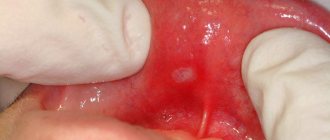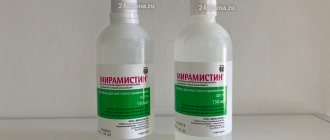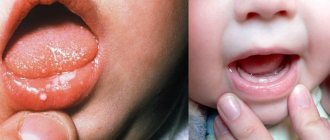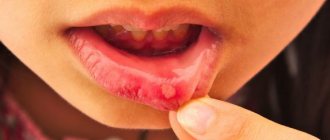Chronic stomatitis is a disease that is accompanied by repeated inflammatory processes of the oral mucosa. Many patients want to know what causes the development of chronic stomatitis. In the vast majority of cases, the development of this pathological condition is associated with a whole complex of various factors - both internal and external.
The most common form today is chronic aphthous stomatitis, which is diagnosed in 5% of cases among all diseases of the oral mucosa.
In our clinic you can get a free dental consultation!
Our doctors
18 years of experience
Baghdasaryan
Armen Evgenievich
Chief physician, dentist-orthopedist-therapist
Graduated from VSMA named after. N.N. Burdenko. Internship on the basis of MGMSU named after. A.E. Evdokimov in “General Dentistry”.
Clinical residency at the Moscow State Medical University named after. A.E. Evdokimov in “Orthopedics”.
More about the doctor...
5 years experience
Sadina
Ekaterina Vladislavovna
Dental therapist, surgeon
Penza State University Medical Institute, specialty “Dentistry”.
In 2016, she underwent professional retraining in the specialty “Therapeutic Dentistry” at the Moscow State Medical and Dental University named after A.I. Evdokimov.
More about the doctor...
8 years of experience
Arzumanov
Andranik Arkadievich
Dentist-orthodontist
Graduated from Moscow State Medical University. Internship - Moscow State Medical University at the Department of Orthodontics and Children's Prosthetics.
Residency at Moscow State Medical University at the Department of Orthodontics and Children's Prosthetics. Member of the Professional Society of Orthodontists of Russia since 2010.
More about the doctor...
Causes
It is customary to identify various causes of chronic stomatitis in adults. They determine the form of the disease:
- The aphthous form can be caused by E. coli, streptococci, or a bacterial allergic reaction. There is a connection with autoimmune pathologies, as well as disruptions in the gastrointestinal tract and endocrine system;
- The candidiasis form develops with long-term use of antibacterial agents when infected with fungi of the genus Candida;
- The herpes form occurs due to the presence of the herpes simplex virus in the body with decreased immunity;
- Prosthetic chronic stomatitis in adults can be caused by various factors: an allergic reaction to the components from which the prosthesis is made; insufficiently good hygiene of dentures; frequent damage to the mucous membrane due to improperly fitted, installed or faulty dentures;
- Vincent's stomatitis can be provoked by spindle-shaped bacillus and Vincent's spirochete against the background of decreased immunity.
We cannot ignore the factors that provoke the development of chronic recurrent stomatitis. These include:
- unbalanced diet;
- taking medications;
- frequent stress;
- acute respiratory diseases;
- hypothermia;
- vitamin deficiency;
- irregular and insufficiently good oral hygiene;
- advanced stages of caries;
- ear, nose and throat infections.
Causes of aphthous stomatitis
- various types of allergies
- antivirus and staphylococcus
- disorders of the immune system
- neurotrophic disorders
- hereditary factors.
Scientists have not fully elucidated all the causes of aphthous stomatitis. So, if we consider chronic recurrent aphthous stomatitis as a manifestation of allergies, then its initiators can be various chemical compounds and foods to which the patient is allergic, dust, toothpaste, waste products of worms, and medications.
Clinical manifestations
The symptoms of chronic stomatitis directly depend on the form of the disease
| Type of acute stomatitis | Clinical manifestations |
| Atrophic |
|
| Vincent |
|
| Herpetic |
|
| Prosthetic |
|
Acute aphthous stomatitis
The most dangerous and widespread form of the disease in children is acute aphthous stomatitis, which affects children of all ages. There are three forms: light, medium and heavy. There is an increase in temperature up to 39 degrees, the formation of many lesions in the oral cavity, ulcers and aphthae. Lesions even appear around the mouth!
If you identify the first symptoms of chronic recurrent autosous stomatitis, you should consult a doctor. Only systematic, consistent treatment can cope with the manifestations of this disease.
Healthy teeth and good health
FDC will be a pleasant find for you and your family on the path to impeccable aesthetics and good health.
Diagnostics
The most important role in diagnosing a disease is to establish the causes of its development. It is they who determine the future tactics of treating inflammatory processes. In order to achieve the desired result, make a smear from the surface of the ulcer, and also carry out:
- study of ulcerative lesions;
- bacteriological examination;
- checking the plasma chain reaction of scrapings.
Treatment
In order to eliminate chronic stomatitis, professional oral hygiene, sanitation of infectious foci and local applications are carried out. As for the specific tactics used for one form or another of the disease, they are presented in the table below
| Type of acute stomatitis | Treatment options |
| Vincent |
|
| Herpetic |
|
| Traumatic |
|
Chronic stomatitis
Symptoms of chronic stomatitis
Chronic recurrent aphthous stomatitis
Clinical signs of this type of stomatitis usually appear during its exacerbation.
Namely, one or two aphthae are formed on the oral mucosa, which are sensitive and painful. Aphtha is a small necrotic lesion on the mucosa, which externally looks like an oval formation with a diameter of up to 10 mm. The area around the aphthae has a bright red tint and is covered with a white fibrinous coating. This focus of necrosis can exist for about two weeks. Typically, the plaque surrounding the aphthae disappears after six days, and the aphthae itself heals within three days. A small red spot appears at the site of the outbreak. In most cases, aphtha is located on the inner surface of the cheeks, the mucous membrane of the lips, under the tongue, on the gums and soft palate.
Between periods of exacerbation, patients are usually diagnosed with long-term remissions, which sometimes last even several years. When an exacerbation of the disease occurs again, it is indicated only by the appearance of foci of necrosis. The general health of the patient usually remains the same. In rare cases, patients complain of fever, weakness, and bad mood.
Chronic ulcerative-necrotic stomatitis of Vincent
This type of chronic stomatitis is most often found in young men aged 17-30 years. The peak of exacerbation of the disease usually occurs in autumn and spring. The first manifestations of the disease are bleeding gums, pain in the mouth, general weakness, and bad breath. Due to intoxication, the patient appears pale. The necrotic process is usually localized on the gum, but then it affects other areas of the oral mucosa.
If necrosis reaches the buccal mucosa, the patient experiences pain and trismus (spasm of the masticatory muscles) when swallowing. In the most difficult cases, facial asymmetry may even occur due to swelling of the surrounding tissue necrosis. The patient’s general condition rapidly deteriorates: the body temperature suddenly rises, headache, weakness, and fainting appear.
Chronic herpetic stomatitis
Signs of herpetic stomatitis usually appear due to overheating, hypothermia, psycho-emotional or physical fatigue. This type of stomatitis is characterized by the constancy of the localization of the rash. If for the first time the rash appeared in the eyes, in the mouth or genitals, then there is a possibility that during a relapse the lesion will appear in the same area.
The most specific signs of the disease are hyperemia of the affected area of the mucosa, the formation of single or multiple blisters, which after opening form erosions, the absence of tissue infiltration, bad breath and severe bleeding. During periods of exacerbation of the disease, patients experience a significant deterioration in general health, loss of appetite, irritability, fatigue, and joint pain. During subsequent relapses, symptoms become less severe.
If a patient is diagnosed with a mild form of the disease, then he experiences an exacerbation twice a year. Small, inflamed areas are found in patients' mouths. The moderate form of the pathology is characterized by relapses no more than four times a year. In patients with a severe form of the herpetic type of disease, relapses appear up to six times a year and are accompanied by the formation of new lesions, headache, and poor appetite.
Chronic denture stomatitis
Denture stomatitis is diagnosed in 50% of patients who use removable dentures. With this type of disease, inflammation affects the area of the mucosa that is in direct contact with the prosthesis. During the examination of the patient, the doctor discovers hyperemia of the prosthetic bed, local bleeding of the gums, and decubital ulcers. Often, due to injury to the mucous membrane, patients develop papillomas and hyperplasia.
Chronic stomatitis of smokers
In most cases, this type of stomatitis is diagnosed in middle-aged men who smoke for a long time. In long-term smokers, the oral mucosa acquires a bluish-brown tint, becomes covered with a white coating, and over time, hyperkeratosis of the palate also develops. It has been proven that smokers with stomatitis are at risk of developing oral cancer.
Where to contact?
You can get treatment for chronic stomatitis at the Good Hands dental clinic. Our specialists are well aware that frequent relapses of the disease can reduce the patient’s quality of life and can provoke the development of periodontitis and benign and malignant oral tumors. They use individual treatment tactics that allow you to achieve good results, make the treatment effective and painless. You can schedule a free consultation with us and find out all the necessary information right now by filling out an application on our website or calling us by phone.
Classification of the disease
Aphthous stomatitis has several forms, which are often directly related to the cause of the disease.
Fibrous
A common form, which is often accompanied by itching, fever and symptoms are much like herpes. Herpetic and aphthous stomatitis differ primarily in the localization of the ulcers. With the aphthous type, they are always located in the mouth and on the tongue (rarely), and not outside, as with herpetic type.
Necrotic
The main causes of necrotizing aphthous stomatitis are somatic diseases and pathologies of the circulatory system. The appearance of aphthae is practically not accompanied by pain, but in the process necrosis of the epithelium and the formation of ulcers occur, touching which already causes significant pain.
Glandular
It occurs due to disruption of the ducts of the minor salivary glands, which is confirmed by the formation of aphthae in this area. Acute respiratory diseases and hypothermia can provoke a relapse of this type of stomatitis.
scarring
Gradular aphthous stomatitis can develop into a scarring stage, in which the ulcers become covered with connective tissue, increase in size and appear even in the palate. Cicatricial aphthous stomatitis takes a long time to treat (ulcers heal for about three months) and requires an integrated approach.
Deforming
The most severe form of the disease. This type of stomatitis leads to deformation of soft tissues and leaves behind noticeable scars.











